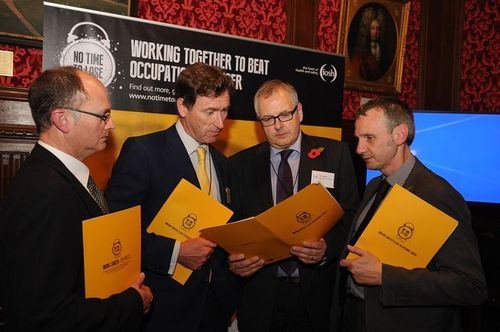It took a lot of preparation, research and a sheer hard work by people here at IOSH to launch our No Time To Lose campaign back in November 2014 at the House of Commons – not to mention lots of coffee and late nights in the office. And since then, we’ve had great success with more than 70 businesses endorsing and pledging support to our campaign. Businesses such as Jaguar Land Rover and Laing O'Rourke to name just two.

- Phil Bates (left) at the House of Commons launch of No Time to Lose
We launched No Time to Lose to engage businesses in the awareness of occupational cancer as well as increase awareness of our own members. There are lots offree material and presentations available for anyone wanting to find out more about occupational cancers. I also wrote an article in Safety Health Practitioner (SHP) in November 2014 to coincide with the launch, as well as helping write and research all the fact sheets produced for the campaign.
The very foundation on which we launched No Time to Lose was
solid research, meaning myself and colleagues from IOSH’s Research and
Information Services team and the Campaigns and Creative team rigorously checking through the latest scientific publications and get experts to
verify and review their content.
This process can take a long time. But it means that the information has a
solid foundation. The campaign has proved a success, generating lots of
interest with thousands of hits on the site as well as requests for materials.
Each time an IOSH No Time to Lose stand appears at one of
our events
up and down the country with factsheets and leaflets it isn’t long before the
holders are empty. People are genuinely interested in what we have to say on
occupational cancers and why we need to raise awareness of the dangers of carcinogens like solar radiation and diesel fumes which can cause harm to those who come into
contact through their work.

- A recent No Time to Lose event at IOSH’s Humber Branch
I believe this is down to a lot of people realising that health issues cause more illness and detriment than pure safety issues. Demonstrating that an employer cares about the health of its employees can really improve engagement. This has been proved time, time and again.
Just after the launch of the campaign, I was asked to do a short presentation at the IOSH
Networks Conference and offered to do a more extended version at
branches, if they wanted. Well, I now have had quite a tour of the UK along
with other volunteers and experts who are willing to give talks to those who
want to find out more about the dangers of occupational cancers. It’s been a
great experience seeing the different branches (quite apart from my own local
district in the Midlands) and I‘ve always had a warm and friendly welcome. This
must be the nature of our members.
Some people are surprised by some of the figures on occupational cancers and
there have been some great and challenging questions. It shows people are
interested in the subject and that we have to keep on top of the current
evidence. Quite often after the presentation, people will come and tell me
their specific stories and incidents. This is perhaps because occupational
cancers can affect a lot of people . However, it’s something we can tackle and
prevent future cases, by implementing controls and principals that we are used
to already.
It isn’t rocket science. It’s based on elimination, substitution, reduction,
control and prevention. My main presentation and notes are now available online
so you can download them and cascade the information to the people you work
with and hopefully together, No Time to Lose can have the positive impact in
raising much-needed awareness of occupational cancers – not only for this
generation of workers, but the next.
If you want to know more about our campaign, contact
us on Twitter or visit our website.
Phil Bates, Senior Policy and
Technical Adviser.
.








